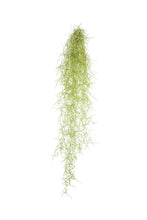
Tillandsia usneoides is part of the Bromeliaceae family and its native range is Tropical & Subtropical America. and is commonly called 'Spanish Moss' (it's neither a moss or from Spain). This epiphyte is typically found wrapped and drooping from the branches or bark of bald cypress, oak, elm, pecan and pine trees. Tillandsia usneoides is grey-green in colour and is made up of downward extending stems, often found in masses, and as long as 20ft. It is covered in absorbent furry scales (trichomes) which enable the plant to absorb water from the humid air.
Tillandsia usneoides is commonly called ‘Spanish Moss’ it is neither of those things. The genus name was given by Carl Linnaeus to honour the Swedish physician and botanist Elias Tillandz (originally Tillander). Specific epithet comes from ‘Usnea’ a lichen that this Tillandsia resembles.
Light: Bright indirect light, meaning the plant sees the sun for 0-4 hours per day - this could be through trees or a translucent curtain, it’s important for the plant to see the sky in order to thrive. South or east facing windows are great and remember the higher the humidity in your space, the more light the plant can tolerate.
Water: You can mist it 2-3 times a week and soak your plant every couple of weeks for 5-10 minutes in tepid water. If you opt to dunk/soak your Tillandsia, gently shake excess water off and turn it upside down so that no water remains trapped between the leaves. Good air circulation is important for Tillandsia. Watering is dependent on how much light the plant is receiving as well as temperature and humidity. Watering ought to be done in the morning time in order to extend drying time.
Fertilising: Feed every other month during the growing season. You can dilute fertiliser to half the recommended amount but never add more.
Temperature: 10-32˚C.
Humidity: Moderate humidity, 60%.
Tillandsia are non-toxic.








